Analysis of Critical Thinking Skills Among QUTIC Int'l Students
VerifiedAdded on 2023/06/04
|10
|1690
|314
Report
AI Summary
This report investigates the critical thinking skills of QUTIC international students, employing a questionnaire-based survey with a sample size of 20 students. The study identifies challenges such as difficulties in independent research and language barriers, despite overall student satisfaction. Data analysis reveals that students find peer-reviewed articles most academically reliable and value independent research for skill development. The report recommends increased group discussions and activities to improve communication skills and reduce language barriers. Furthermore, QUTIC should focus on providing effective learning materials and encouraging independent research. The research successfully meets its objectives by evaluating critical thinking and providing actionable recommendations, with the full report and similar resources available on Desklib.

Communication skills
Student Name
University Name
Student Name
University Name
Paraphrase This Document
Need a fresh take? Get an instant paraphrase of this document with our AI Paraphraser
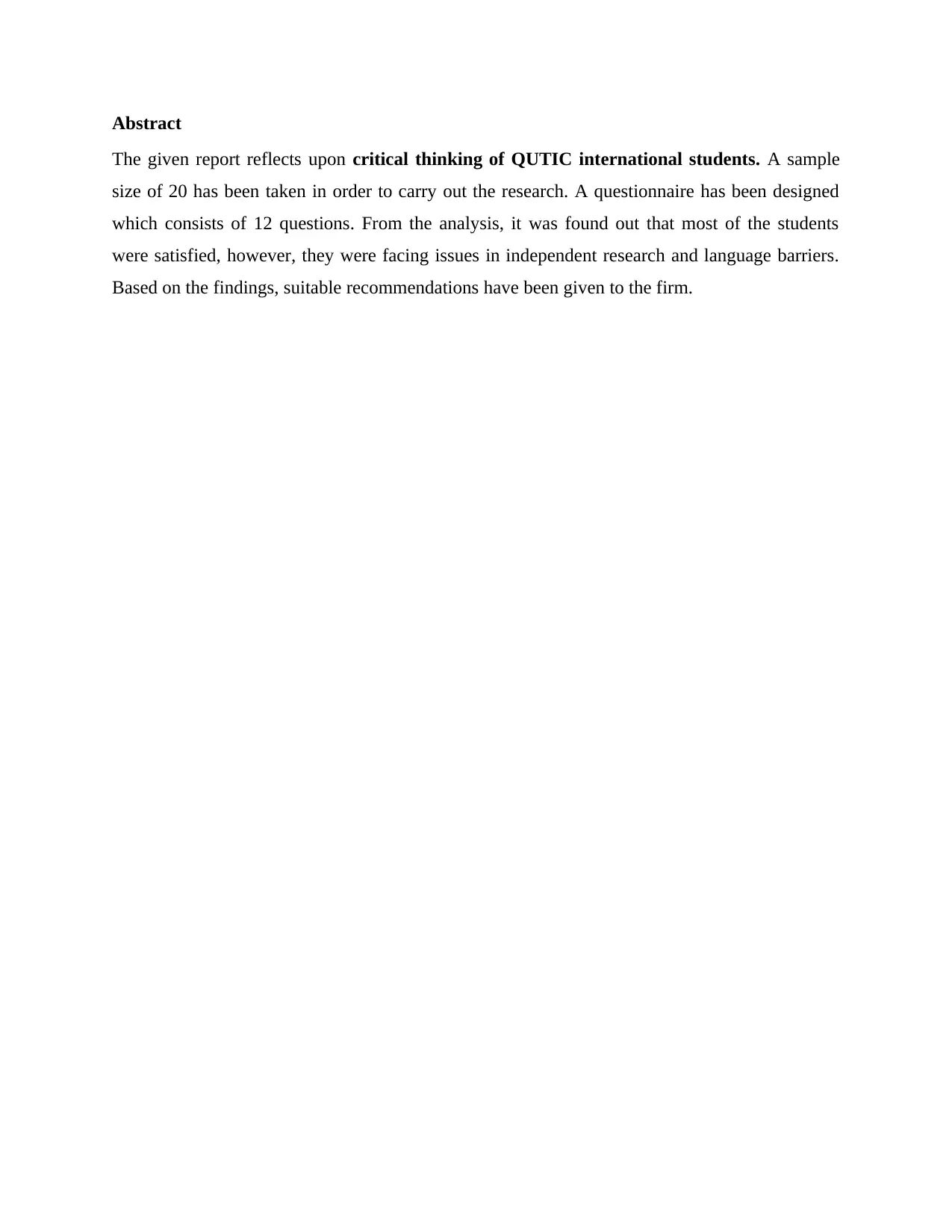
Abstract
The given report reflects upon critical thinking of QUTIC international students. A sample
size of 20 has been taken in order to carry out the research. A questionnaire has been designed
which consists of 12 questions. From the analysis, it was found out that most of the students
were satisfied, however, they were facing issues in independent research and language barriers.
Based on the findings, suitable recommendations have been given to the firm.
The given report reflects upon critical thinking of QUTIC international students. A sample
size of 20 has been taken in order to carry out the research. A questionnaire has been designed
which consists of 12 questions. From the analysis, it was found out that most of the students
were satisfied, however, they were facing issues in independent research and language barriers.
Based on the findings, suitable recommendations have been given to the firm.
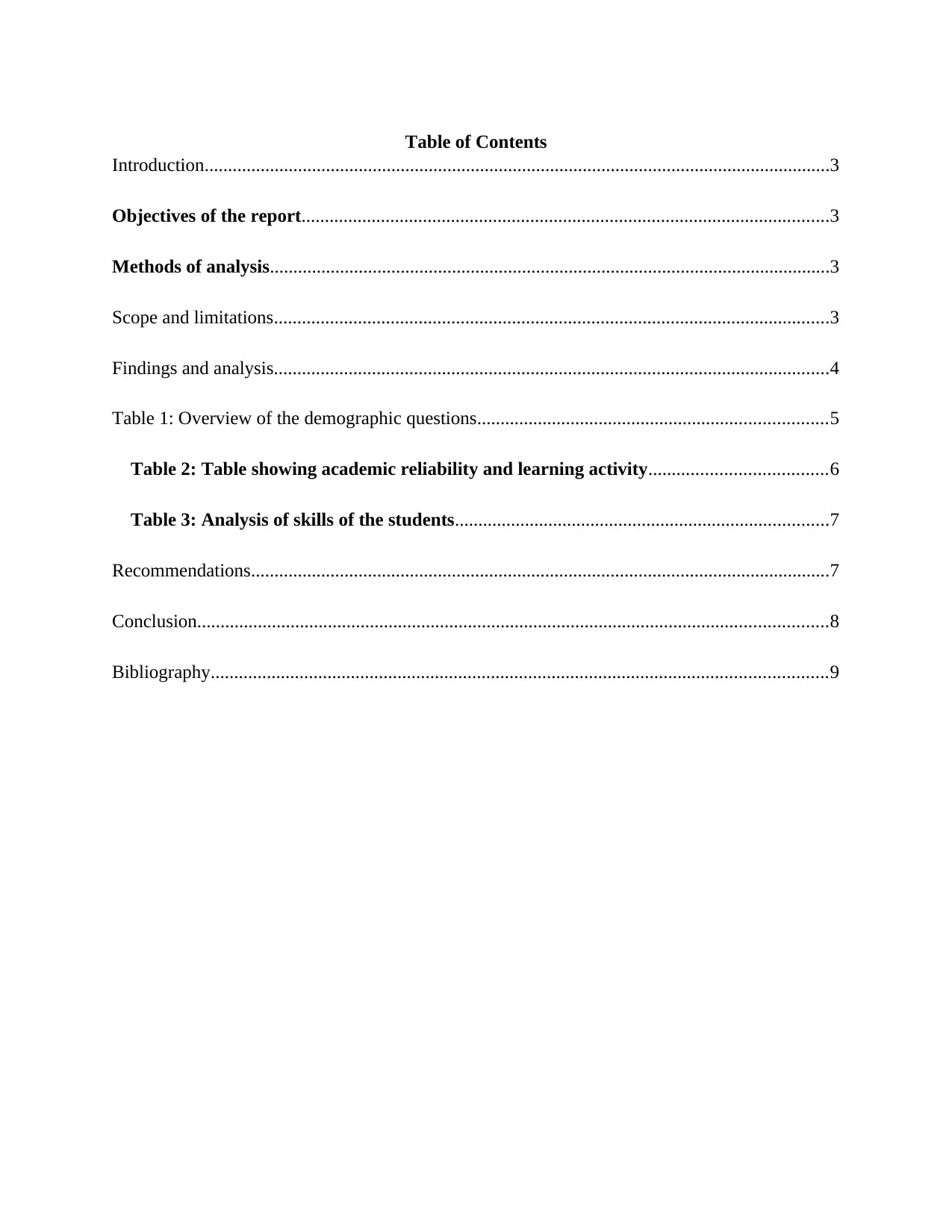
Table of Contents
Introduction......................................................................................................................................3
Objectives of the report.................................................................................................................3
Methods of analysis........................................................................................................................3
Scope and limitations.......................................................................................................................3
Findings and analysis.......................................................................................................................4
Table 1: Overview of the demographic questions...........................................................................5
Table 2: Table showing academic reliability and learning activity......................................6
Table 3: Analysis of skills of the students................................................................................7
Recommendations............................................................................................................................7
Conclusion.......................................................................................................................................8
Bibliography....................................................................................................................................9
Introduction......................................................................................................................................3
Objectives of the report.................................................................................................................3
Methods of analysis........................................................................................................................3
Scope and limitations.......................................................................................................................3
Findings and analysis.......................................................................................................................4
Table 1: Overview of the demographic questions...........................................................................5
Table 2: Table showing academic reliability and learning activity......................................6
Table 3: Analysis of skills of the students................................................................................7
Recommendations............................................................................................................................7
Conclusion.......................................................................................................................................8
Bibliography....................................................................................................................................9
⊘ This is a preview!⊘
Do you want full access?
Subscribe today to unlock all pages.

Trusted by 1+ million students worldwide

Introduction
Background
The main aim of the project is to analyze critical thinking of QUTIC international students. It
is of outmost essence is to identify the issues faced by the students and to provide
recommendations based upon findings and analysis of the responses.
Objectives of the report
The objectives of the report is as follows:-
To evaluate the critical thinking of the students of QUTIC
To evaluate the effectiveness of the course
To provide them recommendations based upon the findings
Methods of analysis
Quantitative data analysis will be used in order to analyze the report. A sample size of 20
students will be selected with the help of random sampling probability method. The
questionnaire consists of 12 questions and 11 questions are of close ended in nature. Apart from
this, the researcher has used a descriptive design and deductive approach in order to analyze the
data.
Scope and limitations
The major limitation of the project is its time frame. Moreover, biasness cannot be judged with
the help of analysis of the given data.
Background
The main aim of the project is to analyze critical thinking of QUTIC international students. It
is of outmost essence is to identify the issues faced by the students and to provide
recommendations based upon findings and analysis of the responses.
Objectives of the report
The objectives of the report is as follows:-
To evaluate the critical thinking of the students of QUTIC
To evaluate the effectiveness of the course
To provide them recommendations based upon the findings
Methods of analysis
Quantitative data analysis will be used in order to analyze the report. A sample size of 20
students will be selected with the help of random sampling probability method. The
questionnaire consists of 12 questions and 11 questions are of close ended in nature. Apart from
this, the researcher has used a descriptive design and deductive approach in order to analyze the
data.
Scope and limitations
The major limitation of the project is its time frame. Moreover, biasness cannot be judged with
the help of analysis of the given data.
Paraphrase This Document
Need a fresh take? Get an instant paraphrase of this document with our AI Paraphraser
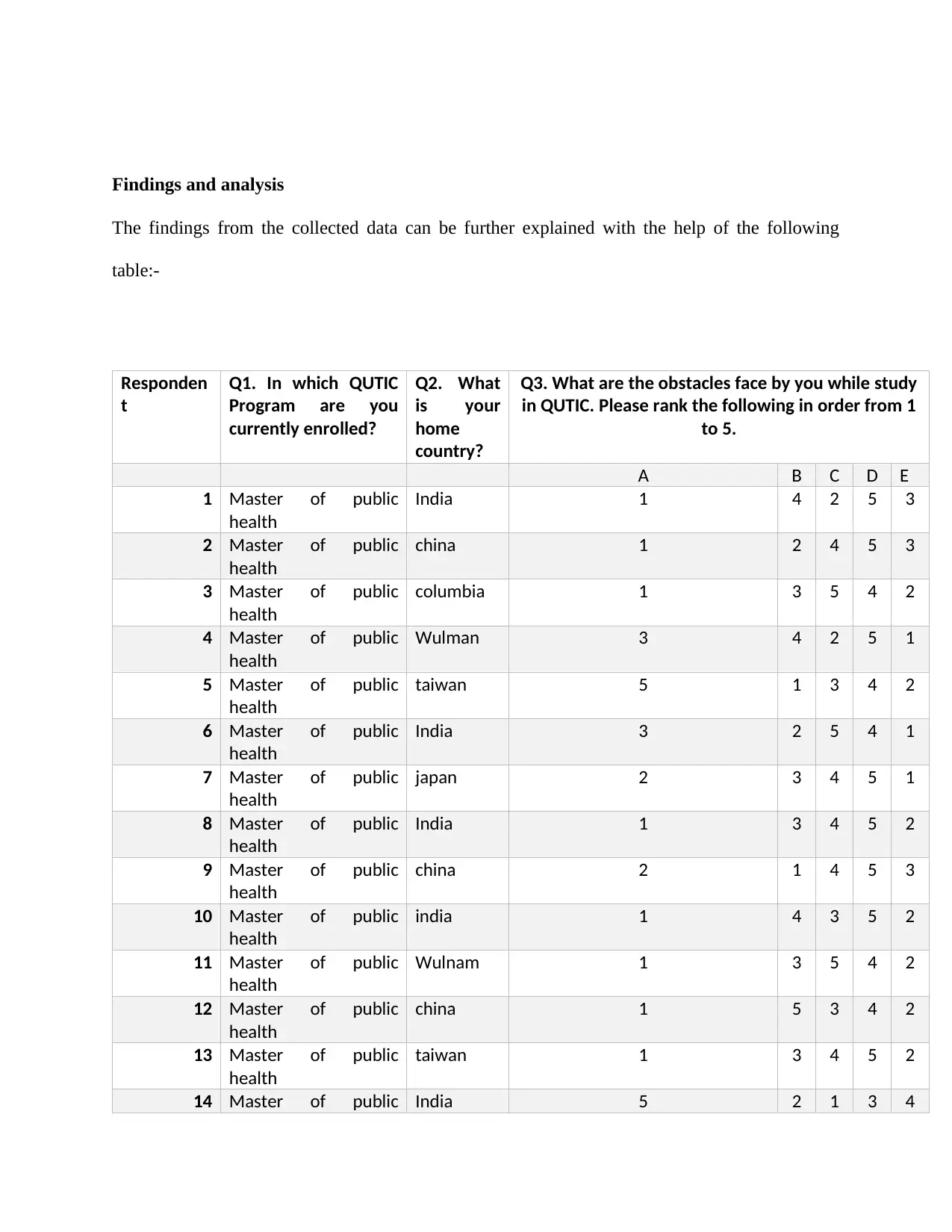
Findings and analysis
The findings from the collected data can be further explained with the help of the following
table:-
Responden
t
Q1. In which QUTIC
Program are you
currently enrolled?
Q2. What
is your
home
country?
Q3. What are the obstacles face by you while study
in QUTIC. Please rank the following in order from 1
to 5.
A B C D E
1 Master of public
health
India 1 4 2 5 3
2 Master of public
health
china 1 2 4 5 3
3 Master of public
health
columbia 1 3 5 4 2
4 Master of public
health
Wulman 3 4 2 5 1
5 Master of public
health
taiwan 5 1 3 4 2
6 Master of public
health
India 3 2 5 4 1
7 Master of public
health
japan 2 3 4 5 1
8 Master of public
health
India 1 3 4 5 2
9 Master of public
health
china 2 1 4 5 3
10 Master of public
health
india 1 4 3 5 2
11 Master of public
health
Wulnam 1 3 5 4 2
12 Master of public
health
china 1 5 3 4 2
13 Master of public
health
taiwan 1 3 4 5 2
14 Master of public India 5 2 1 3 4
The findings from the collected data can be further explained with the help of the following
table:-
Responden
t
Q1. In which QUTIC
Program are you
currently enrolled?
Q2. What
is your
home
country?
Q3. What are the obstacles face by you while study
in QUTIC. Please rank the following in order from 1
to 5.
A B C D E
1 Master of public
health
India 1 4 2 5 3
2 Master of public
health
china 1 2 4 5 3
3 Master of public
health
columbia 1 3 5 4 2
4 Master of public
health
Wulman 3 4 2 5 1
5 Master of public
health
taiwan 5 1 3 4 2
6 Master of public
health
India 3 2 5 4 1
7 Master of public
health
japan 2 3 4 5 1
8 Master of public
health
India 1 3 4 5 2
9 Master of public
health
china 2 1 4 5 3
10 Master of public
health
india 1 4 3 5 2
11 Master of public
health
Wulnam 1 3 5 4 2
12 Master of public
health
china 1 5 3 4 2
13 Master of public
health
taiwan 1 3 4 5 2
14 Master of public India 5 2 1 3 4

health
15 Master of public
health
Banglades
h
1 4 2 5 3
16 Master of public
health
china 1 4 2 5 3
17 Master of public
health
taiwan 1 2 4 5 3
18 Master of public
health
India 1 2 4 5 3
19 Master of public
health
india 5 3 1 2 4
20 Master of public
health
solomon
island
5 1 4 3 2
Total 42 56 66 88 48
Table 1: Overview of the demographic questions
From the above table, it can be inferred the selected students are from different parts of the
world. In the third question, the students were asked regarding the obstacles that they face while
studying. From the above table, it can be inferred that most of the students have ranked
independent research regarding their first obstacle while studying in QUTIC, as the total is the
least among the data collected. Independent research is closing followed by language barrier.
Due to the wide diversity of the students, language barrier can be considered as the biggest
challenge of the university in order to manage the students.
The next two questions about academic reliability and learning activity. The major findings of
the data can be further explained with the help of the following table:-
Q4. Rank sources from 1 to 4
according to academic reliability.
Q5. Which learning activity helps you to develop evaluative skill the
most?
A B C D A B C D
1 4 3 2 1
4 3 2 1 1
2 1 4 3 1
15 Master of public
health
Banglades
h
1 4 2 5 3
16 Master of public
health
china 1 4 2 5 3
17 Master of public
health
taiwan 1 2 4 5 3
18 Master of public
health
India 1 2 4 5 3
19 Master of public
health
india 5 3 1 2 4
20 Master of public
health
solomon
island
5 1 4 3 2
Total 42 56 66 88 48
Table 1: Overview of the demographic questions
From the above table, it can be inferred the selected students are from different parts of the
world. In the third question, the students were asked regarding the obstacles that they face while
studying. From the above table, it can be inferred that most of the students have ranked
independent research regarding their first obstacle while studying in QUTIC, as the total is the
least among the data collected. Independent research is closing followed by language barrier.
Due to the wide diversity of the students, language barrier can be considered as the biggest
challenge of the university in order to manage the students.
The next two questions about academic reliability and learning activity. The major findings of
the data can be further explained with the help of the following table:-
Q4. Rank sources from 1 to 4
according to academic reliability.
Q5. Which learning activity helps you to develop evaluative skill the
most?
A B C D A B C D
1 4 3 2 1
4 3 2 1 1
2 1 4 3 1
⊘ This is a preview!⊘
Do you want full access?
Subscribe today to unlock all pages.

Trusted by 1+ million students worldwide
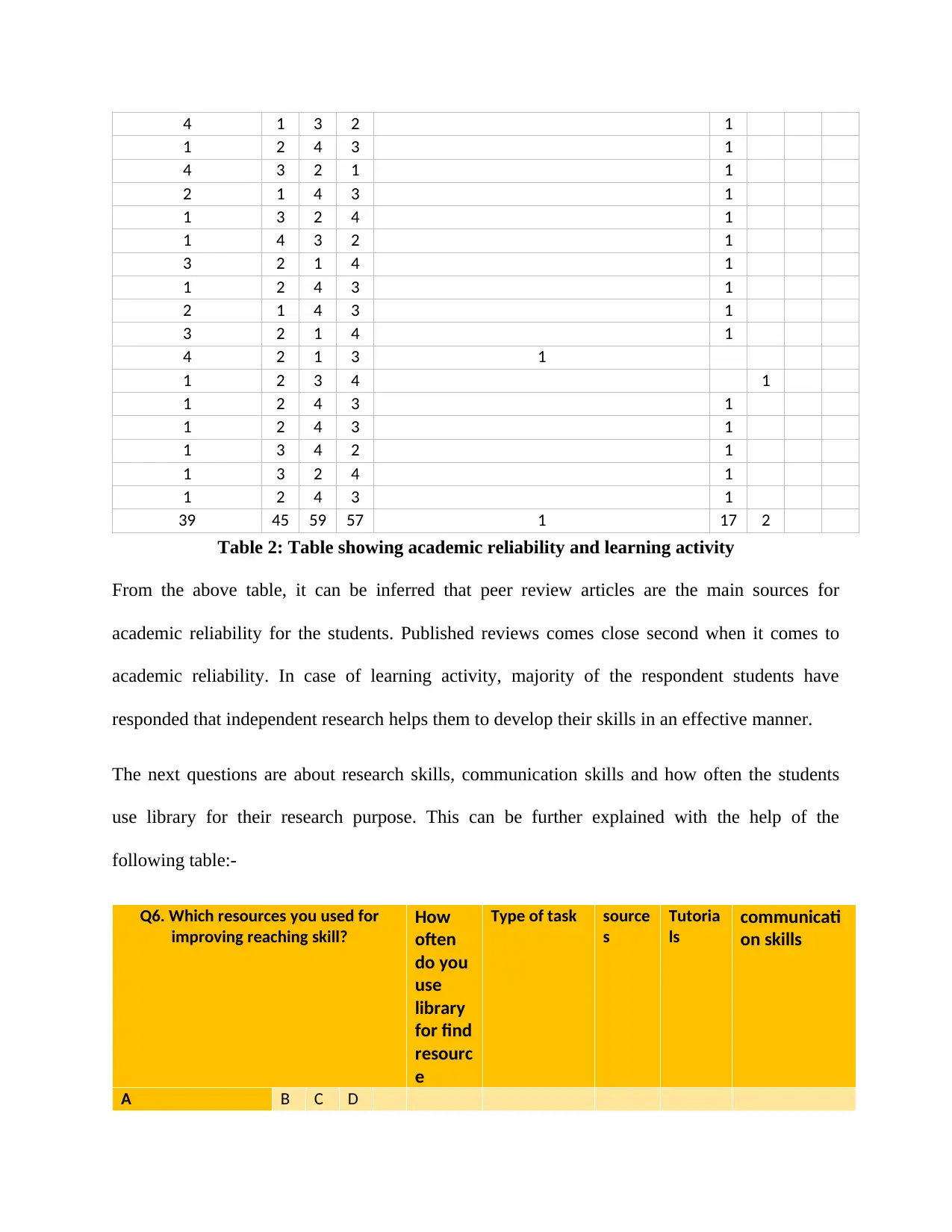
4 1 3 2 1
1 2 4 3 1
4 3 2 1 1
2 1 4 3 1
1 3 2 4 1
1 4 3 2 1
3 2 1 4 1
1 2 4 3 1
2 1 4 3 1
3 2 1 4 1
4 2 1 3 1
1 2 3 4 1
1 2 4 3 1
1 2 4 3 1
1 3 4 2 1
1 3 2 4 1
1 2 4 3 1
39 45 59 57 1 17 2
Table 2: Table showing academic reliability and learning activity
From the above table, it can be inferred that peer review articles are the main sources for
academic reliability for the students. Published reviews comes close second when it comes to
academic reliability. In case of learning activity, majority of the respondent students have
responded that independent research helps them to develop their skills in an effective manner.
The next questions are about research skills, communication skills and how often the students
use library for their research purpose. This can be further explained with the help of the
following table:-
Q6. Which resources you used for
improving reaching skill?
How
often
do you
use
library
for find
resourc
e
Type of task source
s
Tutoria
ls
communicati
on skills
A B C D
1 2 4 3 1
4 3 2 1 1
2 1 4 3 1
1 3 2 4 1
1 4 3 2 1
3 2 1 4 1
1 2 4 3 1
2 1 4 3 1
3 2 1 4 1
4 2 1 3 1
1 2 3 4 1
1 2 4 3 1
1 2 4 3 1
1 3 4 2 1
1 3 2 4 1
1 2 4 3 1
39 45 59 57 1 17 2
Table 2: Table showing academic reliability and learning activity
From the above table, it can be inferred that peer review articles are the main sources for
academic reliability for the students. Published reviews comes close second when it comes to
academic reliability. In case of learning activity, majority of the respondent students have
responded that independent research helps them to develop their skills in an effective manner.
The next questions are about research skills, communication skills and how often the students
use library for their research purpose. This can be further explained with the help of the
following table:-
Q6. Which resources you used for
improving reaching skill?
How
often
do you
use
library
for find
resourc
e
Type of task source
s
Tutoria
ls
communicati
on skills
A B C D
Paraphrase This Document
Need a fresh take? Get an instant paraphrase of this document with our AI Paraphraser
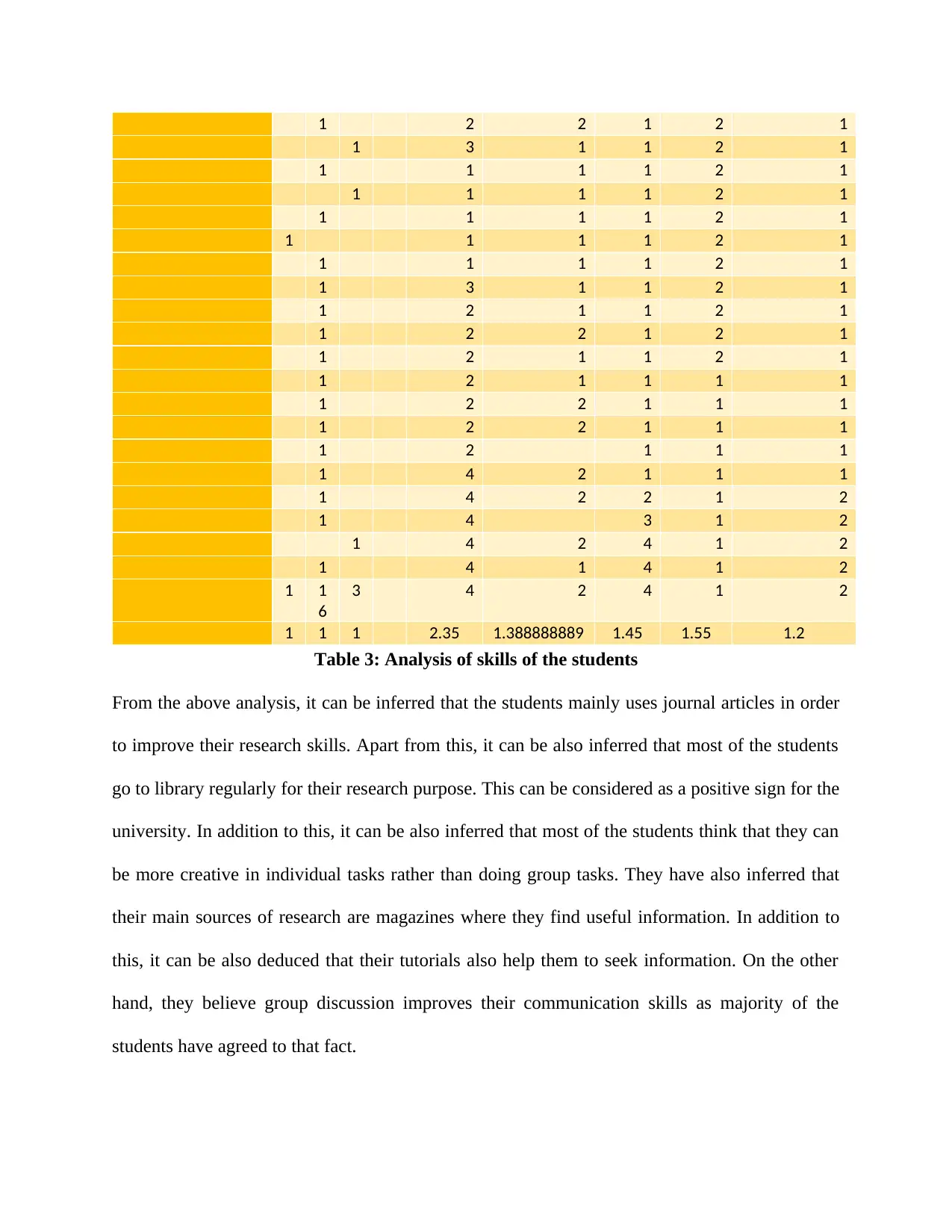
1 2 2 1 2 1
1 3 1 1 2 1
1 1 1 1 2 1
1 1 1 1 2 1
1 1 1 1 2 1
1 1 1 1 2 1
1 1 1 1 2 1
1 3 1 1 2 1
1 2 1 1 2 1
1 2 2 1 2 1
1 2 1 1 2 1
1 2 1 1 1 1
1 2 2 1 1 1
1 2 2 1 1 1
1 2 1 1 1
1 4 2 1 1 1
1 4 2 2 1 2
1 4 3 1 2
1 4 2 4 1 2
1 4 1 4 1 2
1 1
6
3 4 2 4 1 2
1 1 1 2.35 1.388888889 1.45 1.55 1.2
Table 3: Analysis of skills of the students
From the above analysis, it can be inferred that the students mainly uses journal articles in order
to improve their research skills. Apart from this, it can be also inferred that most of the students
go to library regularly for their research purpose. This can be considered as a positive sign for the
university. In addition to this, it can be also inferred that most of the students think that they can
be more creative in individual tasks rather than doing group tasks. They have also inferred that
their main sources of research are magazines where they find useful information. In addition to
this, it can be also deduced that their tutorials also help them to seek information. On the other
hand, they believe group discussion improves their communication skills as majority of the
students have agreed to that fact.
1 3 1 1 2 1
1 1 1 1 2 1
1 1 1 1 2 1
1 1 1 1 2 1
1 1 1 1 2 1
1 1 1 1 2 1
1 3 1 1 2 1
1 2 1 1 2 1
1 2 2 1 2 1
1 2 1 1 2 1
1 2 1 1 1 1
1 2 2 1 1 1
1 2 2 1 1 1
1 2 1 1 1
1 4 2 1 1 1
1 4 2 2 1 2
1 4 3 1 2
1 4 2 4 1 2
1 4 1 4 1 2
1 1
6
3 4 2 4 1 2
1 1 1 2.35 1.388888889 1.45 1.55 1.2
Table 3: Analysis of skills of the students
From the above analysis, it can be inferred that the students mainly uses journal articles in order
to improve their research skills. Apart from this, it can be also inferred that most of the students
go to library regularly for their research purpose. This can be considered as a positive sign for the
university. In addition to this, it can be also inferred that most of the students think that they can
be more creative in individual tasks rather than doing group tasks. They have also inferred that
their main sources of research are magazines where they find useful information. In addition to
this, it can be also deduced that their tutorials also help them to seek information. On the other
hand, they believe group discussion improves their communication skills as majority of the
students have agreed to that fact.

Recommendations
From the above analysis, it can be recommended that the students need to involve in group
discussions and group work in order to improve their learning and communication skills.
QUTIC needs to focus in minimizing the language barriers with the help of various group
activities. In addition to this, the university needs to focus on effective learning materials in order
to enhance the skills of the student and they must also encourage students to do carry out their
research in an independent manner.
Conclusion
From the above analysis, it can be concluded that most of the students have said positive things
about QUTIC. However, several steps can be taken in order to improve and develop various
skills of the student and minimize their obstacles. In addition to this, it can be inferred that the
research aims and objectives have been successfully met.
From the above analysis, it can be recommended that the students need to involve in group
discussions and group work in order to improve their learning and communication skills.
QUTIC needs to focus in minimizing the language barriers with the help of various group
activities. In addition to this, the university needs to focus on effective learning materials in order
to enhance the skills of the student and they must also encourage students to do carry out their
research in an independent manner.
Conclusion
From the above analysis, it can be concluded that most of the students have said positive things
about QUTIC. However, several steps can be taken in order to improve and develop various
skills of the student and minimize their obstacles. In addition to this, it can be inferred that the
research aims and objectives have been successfully met.
⊘ This is a preview!⊘
Do you want full access?
Subscribe today to unlock all pages.

Trusted by 1+ million students worldwide

Bibliography
Borg, S. (2015). Teacher cognition and language education: Research and practice. Bloomsbury
Publishing.
Kramsch, C. (2014). Teaching foreign languages in an era of globalization: Introduction. The
modern language journal, 98(1), 296-311.
Kumashiro, K. K. (2015). Against common sense: Teaching and learning toward social justice.
Routledge.
Nunan, D. (2015). Teaching English to speakers of other languages: An introduction. Routledge.
Richards, J. C., & Rodgers, T. S. (2014). Approaches and methods in language teaching.
Cambridge university press.
Rivers, W. M. (2018). Teaching foreign-language skills. University of Chicago Press.
Shrum, J. L., & Glisan, E. W. (2015). Teacher's handbook, contextualized language instruction.
Cengage Learning.
Borg, S. (2015). Teacher cognition and language education: Research and practice. Bloomsbury
Publishing.
Kramsch, C. (2014). Teaching foreign languages in an era of globalization: Introduction. The
modern language journal, 98(1), 296-311.
Kumashiro, K. K. (2015). Against common sense: Teaching and learning toward social justice.
Routledge.
Nunan, D. (2015). Teaching English to speakers of other languages: An introduction. Routledge.
Richards, J. C., & Rodgers, T. S. (2014). Approaches and methods in language teaching.
Cambridge university press.
Rivers, W. M. (2018). Teaching foreign-language skills. University of Chicago Press.
Shrum, J. L., & Glisan, E. W. (2015). Teacher's handbook, contextualized language instruction.
Cengage Learning.
1 out of 10
Related Documents
Your All-in-One AI-Powered Toolkit for Academic Success.
+13062052269
info@desklib.com
Available 24*7 on WhatsApp / Email
![[object Object]](/_next/static/media/star-bottom.7253800d.svg)
Unlock your academic potential
Copyright © 2020–2025 A2Z Services. All Rights Reserved. Developed and managed by ZUCOL.





